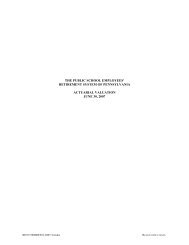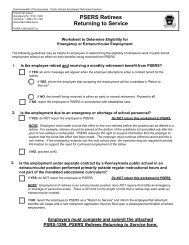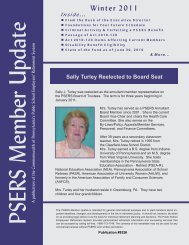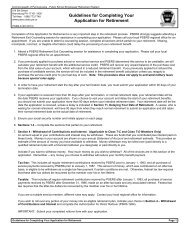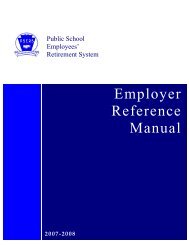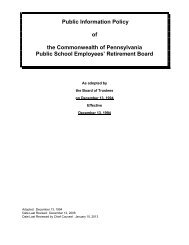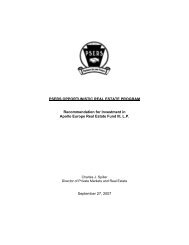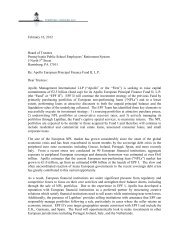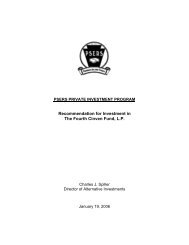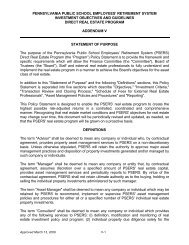a complete copy of the 2012 CAFR Report! - PSERs
a complete copy of the 2012 CAFR Report! - PSERs
a complete copy of the 2012 CAFR Report! - PSERs
You also want an ePaper? Increase the reach of your titles
YUMPU automatically turns print PDFs into web optimized ePapers that Google loves.
FINANCIAL SECTION<br />
Management’s Discussion and Analysis (continued)<br />
Alternative<br />
investments<br />
26%<br />
Real estate<br />
12%<br />
Asset Distribution<br />
June 30, <strong>2012</strong><br />
Common &<br />
preferred stock<br />
19%<br />
Collective<br />
trust funds<br />
22%<br />
Fixed Income<br />
15%<br />
Short-term<br />
6%<br />
Short-term investments (cash and cash equivalents)<br />
decreased by $3.2 billion from $5.8 billion at June 30,<br />
2011 to $2.6 billion at June 30, <strong>2012</strong>. This asset class was<br />
overweighted at June 30, 2011 and underweighted at June<br />
30, <strong>2012</strong> according to <strong>the</strong> asset allocation plans approved<br />
by <strong>the</strong> Board. Due to manager terminations, reallocation<br />
<strong>of</strong> investments and funding for benefit payments, PSERS<br />
decreased its short-term investments during FY <strong>2012</strong>.<br />
Fixed income investments decreased by $1.3 billion from<br />
$8.5 billion at June 30, 2011 to $7.2 billion at June 30, <strong>2012</strong><br />
mostly due to manager terminations and reallocation <strong>of</strong><br />
exposure to o<strong>the</strong>r asset classes during FY <strong>2012</strong>. Common<br />
and preferred stock investments also decreased by $1.6<br />
billion from $11.0 billion at June 30, 2011 to $9.4 billion<br />
at June 30, <strong>2012</strong>. The reduction in this asset category was<br />
mainly <strong>the</strong> result <strong>of</strong> negative returns in <strong>the</strong> international<br />
equity market. Collective trust funds rose by $1.9 billion<br />
from $8.6 billion at June 30, 2011 to $10.5 billion at June<br />
30, <strong>2012</strong> mostly due to a reallocation <strong>of</strong> exposure from<br />
o<strong>the</strong>r asset classes. Real estate investments increased by<br />
$700 million from $5.3 billion at June 30, 2011 to $6.0<br />
billion at June 30, <strong>2012</strong> due to contributions to new and<br />
existing partnerships combined with a recovery <strong>of</strong> value in<br />
partnership portfolio holdings.<br />
Short-term investments (cash and cash equivalents)<br />
increased by $1.6 billion from $4.2 billion at June 30, 2010<br />
to $5.8 billion at June 30, 2011 due to a reallocation <strong>of</strong><br />
exposure from common and preferred stocks during FY<br />
2011. Collective trust funds increased by $1 billion from<br />
$7.6 billion at June 30, 2010 to $8.6 billion at June 30, 2011<br />
due to market value appreciation and allocation increases<br />
to <strong>the</strong> asset class. Real estate investments rose by $1.3<br />
billion from $4.0 billion at June 30, 2010 to $5.3 billion<br />
at June 30, 2011 mostly as a result <strong>of</strong> contributions to new<br />
and existing partnerships combined with market recovery.<br />
Alternative investments increased by $1.4 billion from<br />
$11.2 billion at June 30, 2010 to $12.6 billion at June 30,<br />
2011 due to contributions to new and existing partnerships<br />
PAGE 30<br />
combined with strong appreciation in partnership portfolio<br />
investments, which outweighed significant distributions.<br />
Securities Lending<br />
The System experienced only a slight change in net income<br />
from securities lending activities from $7.2 million in FY<br />
2011 to $8.3 million in FY <strong>2012</strong> as spreads improved and<br />
volume increased.<br />
Contributions<br />
Employer contributions increased from $747.8 million in<br />
FY 2011 to $1.1 billion in FY <strong>2012</strong> due to <strong>the</strong> increase<br />
in <strong>the</strong> total employer contribution rate from 5.64% in FY<br />
2011 to 8.65% in FY <strong>2012</strong>. The decrease in active member<br />
payroll partially <strong>of</strong>fset <strong>the</strong> increase in contribution rate.<br />
Active member payroll decreased 2.6% from FY 2011 to<br />
FY <strong>2012</strong>. This was <strong>the</strong> first active member payroll decrease<br />
in over 20 years.<br />
Total member contributions decreased from $1.24 billion<br />
in FY 2011 to $1.17 billion in FY <strong>2012</strong> due to a decrease<br />
in active member payroll for pension <strong>of</strong>fset by a slight<br />
increase in <strong>the</strong> average member contribution rate and<br />
increased participation in <strong>the</strong> HOP. The average member<br />
contribution rate for pension increased from 7.34% in FY<br />
2011 to 7.37% in FY <strong>2012</strong>. Total member contributions<br />
increased from $1.14 billion in FY 2010 to $1.24 billion<br />
in FY 2011 as a result <strong>of</strong> <strong>the</strong> increase in <strong>the</strong> average<br />
member contribution rate and total active member payroll<br />
for pension and increased participation in <strong>the</strong> HOP. The<br />
average member contribution rate for pension increased<br />
from 7.32% in FY 2010 to 7.34% in FY 2011.<br />
A thirty-year history <strong>of</strong> PSERS’ contribution rates is<br />
presented on <strong>the</strong> next page.<br />
As a result <strong>of</strong> a decrease in active member payrolls and<br />
a decrease in service credit purchases by members from<br />
FY 2011 to FY <strong>2012</strong>, member contribution receivables<br />
decreased from $306.4 million at June 30, 2011 to $290.1<br />
million at June 30, <strong>2012</strong>. The increase in <strong>the</strong> employer<br />
contribution rate from FY 2011 to FY <strong>2012</strong> <strong>of</strong>fset <strong>the</strong> effects<br />
<strong>of</strong> <strong>the</strong> decrease in <strong>the</strong> active member payrolls and lower<br />
employer cost <strong>of</strong> service credit purchases and resulted in<br />
<strong>the</strong> employer contribution receivable rising from $224.6<br />
million at June 30, 2011 to $319.2 million at June 30, <strong>2012</strong>.




